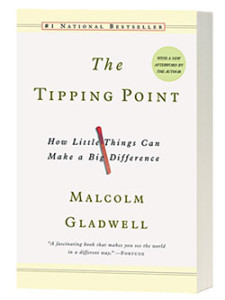
This article was originally published a few years ago at the RockStar Success Library. It’s ideas were influential as I was writing Networking in the 21st Century.
The Tipping Point is the biography of an idea…Ideas and products and messages spread just like viruses do” (pg. 7). That’s the description of the book straight from Malcolm Gladwell’s mouth, er, keyboard. Basically a sociological and psychological study on how cultural ideas spread, The Tipping Point offers an interesting examination and extrapolation of the factors that cause a message to become “viral”. All you have to do is google viral marketing and you’ll see the hold this has on people’s minds right now.
Malcolm breaks down the causes needed for an idea to become truly viral into three main areas. The subtext that he would add to these three areas, is that a drastic change in any of them isn’t necessary for a message to spread successfully. As the title of the book suggests, there is often just a small change needed to help an idea find it’s tipping point.
- The Law of the Few – An idea doesn’t need to have a massive number of proponents to be replicated – it just needs a few who fit into some important parameters. Connectors know a lot of people and can spread an idea to those people. Mavens are storehouses of information and become trusted reference resources for those that know them. And Salespeople are experts and influencing the opinions of others.
- The Stickiness Factor – “There is a simple way to package information that, under the right circumstances, can make it irresistible. All you have to do is find it.” (p. 132). The stickiness of a message refers to its ability to “stick” in your mind. It’s hard to transmit a message that people forget. Malcolm is suggesting that by changing the way information is presented, you can change an individual’s ability to grasp it.
- The Power of Context – The framework in which a message is received creates and influences a lot of its meaning. These are the “right” circumstances referred to above. It can be a change in the physical or social environment that causes people to be more receptive to an idea. This is especially an area in which there doesn’t need to be a huge shift, just a marginal one that can have a huge effect (see the Rule of 150 below).
Implications, Questions,and Ideas
- One of the biggest implications that I take out of The Tipping Point is the power of a marginal change making a huge impact. This is especially true in marketing – there is a critical tipping point that a business has to reach before . This tipping point also applies to really any new endeavor that someone tries.
- An interesting observation that Malcolm makes about Connectors is that they know a lot of people from different social spheres. It’s not just that they have a lot of depth in one group, but in many groups. That allows them to pull the people/ideas from one group across social boundaries. I think this is especially relevant for people who consider themselves good “networkers”. It’s important to create strong connections with a number of different groups of people.
- The Magic Number of 150. This idea states that once a group’s size gets above a certain number that some of the strong social ties that bind that group lose cohesiveness. there are simply too many people to know well at a higher number. It makes sense, and even if the magic number isn’t 150, it’s probably around there somewhere. This has big implications if you are the leader of a group – a business owner perhaps, or the president of local community group. If the group gets too large, you’ll find that it’s harder to create consensus – so find ways to keep it small (in structure at least). In some ways, this demonstrates the marginal quality of the tipping point idea as well. If you go from 50 to 140 members in the group, nothing dramatically changes, but if you go from 150 to 160, the group becomes frayed and stressed.
- “…in order to create one contagious movement, you have often have to create many small movements first” (p. 192). This has a lot of resonance for me as a business owner who works a lot by referral and word of mouth advertising. To create the buzz I want around my business, my goal is to create a lot of pockets of interest that continue to grow. It’s like starting a lot of small fires that build into one large one.
Should you read this book?
Yep. It’s a fun read and makes some very interesting points. Malcolm is a writer for the New Yorker so he knows how to write – he tells a good story. Sometimes he overwhelms with the variety of support material for each of his main ideas, and sometimes the conclusions he makes are a little off (in my onion); overall he presents a lot of information clearly and convincingly and spurs a lot of thought. And any book that makes you think is good in my book (sorry for the pun).
